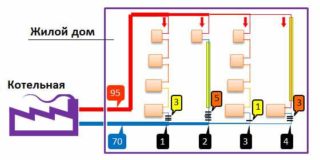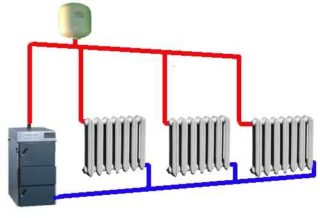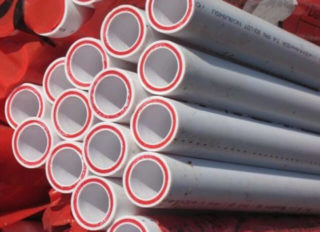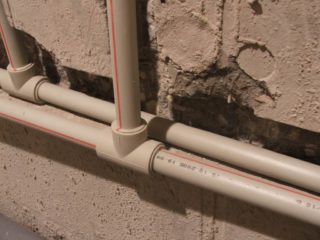SNiP 2.04.05-86 in Appendix No. 10 gives instructions on the use of steam and water heating systems in industry and everyday life. Steam is used in production, water in housing stock. Steam heats heating appliances to temperatures above 100 ° C, which is dangerous for residents. This document does not apply to private households. The physics of steam heating processes consists in the use of dry steam, which, when condensed, emits a lot of heat. In the process of condensation of 1 kg of steam, 2300 kJ of thermal energy is released. Water cooled to 50 ° C gives 120 kJ.
Steam heating
The difference in the energy released explains the advantages of steam heating:
- reduced number of radiators;
- quick warm-up of the system;
- lack of the effect of “defrosting” during breaks in work;
- Significantly lower heating costs during installation and operation.
The second and third points are important for cottages and country houses - buildings in which residents are on short visits.
According to the vapor pressure used in the system, there are:
- High pressure systems (over 6 atm) - allow you to heat large areas with long pressure and condenser lines.
- Low pressure (1.7-6 atm) - may be used in private housing.
- Vacuum (pressure less than 1 atm) - interesting in their ability to realize boiling water at temperatures below 100 ° C and reduce the temperature of heating devices to safe. They are used extremely rarely due to the need to ensure high tightness of the system.
A system communicating with the atmosphere is considered “open”, not communicating - “closed”.

The disadvantages of steam include:
- excessive heating of pipes and radiators;
- wear of system elements due to steam aggressiveness;
- noises accompanying the operation of the system.
During installation, one-pipe and two-pipe wiring schemes are used. In the first case, steam and condensate move along the same pipe. Steam comes from the boiler, condensate - towards him. In a two-pipe one, steam enters the radiators through the pressure line and, condensing into them, returns to the tank for collecting it or directly to the boiler via the gravity-flow condenser line in the form of water.
The slope when laying steam heating is taken in 1-2% in the direction of movement of steam and condensate for two-pipe systems. The same 1-2% in the direction of condensate movement is taken for a single-pipe system.
Water heating
The popularity of water heating is explained by safety and great comfort. There are systems with natural and forced circulation. In the former, the movement of the heat carrier occurs due to the difference in the specific gravity of hot and cold water, and in the latter, it is provided by a circulation pump. Single-tube and two-tube installation schemes are used.
With natural circulation, the slope is taken within 5-10 mm per linear meter of pipe. The slope in the heating system is arranged in the direction of water movement, i.e. the pressure line is tilted from the boiler to the radiators, and the return pipe from the radiators to the boiler. The water heater must be located below the radiators, which may lead to the need to place the boiler in the pit. In a private house, this does not create problems. If the bias leads to a similar result during the installation of heating in the apartment, it is necessary to increase the height of the radiators and reduce the slopes of the pipes.We have to decide what the minimum slope in heating with natural circulation can be adopted without compromising performance. Practice suggests a value of 5 mm per linear meter. You can familiarize yourself with regulatory requirements in SNiP 2.04.05.-91 *.
To create the movement of water in complex systems, pumps are used. If the pump provides a flow rate of more than 0.25 m per second, there may be no pipe slope. It is important that the air plugs move faster than the fluid and collect near air valves located at the top of the system. During operation, repairs are required that require the coolant to be drained. Therefore, the slopes of the pipes, it is desirable to perform so as to ensure complete discharge of the coolant.
What is the minimum slope for water heating systems depends on the specific circumstances. It should not be less than 3 mm per 1 m. The angle of inclination of the single-pipe heating line is chosen based on the same considerations.
Characteristics of heating pipes
Pipes used in heating systems are divided into metal and plastic. The first include:
- steel;
- from stainless steel;
- corrugated stainless steel;
- copper.
The listed materials are durable and have high operational properties, but are expensive and difficult to install. Their use is justified in steam heating systems.
Plastic pipes are:
- metal-plastic;
- polypropylene;
- made of cross-linked polyethylene.
Their common advantages include ease of installation, low weight, reasonable price.
Installation and assembly recommendations
Starting installation, it is necessary in accordance with the existing heating system design to determine the location of the boiler, radiators, pumps, expansion tank, etc. Next, with the help of the level, marks are applied to the walls indicating what kind of slope the heating system should have in all its sections. When installing heating pipelines with forced circulation, slopes can be omitted.
Post-installation system tests
After installation, visually check the quality of the work performed. The main objective of the test is to identify leaks. The hydrostatic method is used, as a rule. The system is filled with water and a pressure of 25-50% higher than the working one is applied. Stand for 1 hour. The total length of the test area should not exceed 100 m. Another way is a compressed air test. Before filling the heating medium with heat, compressed air with a pressure of 1-1.5 atm higher than the working pressure is supplied to the system, and the pressure drop is monitored for 30 minutes. If there is no fall, the system is tight. Otherwise, they are looking for a leak. Determine the flow by soaping.






